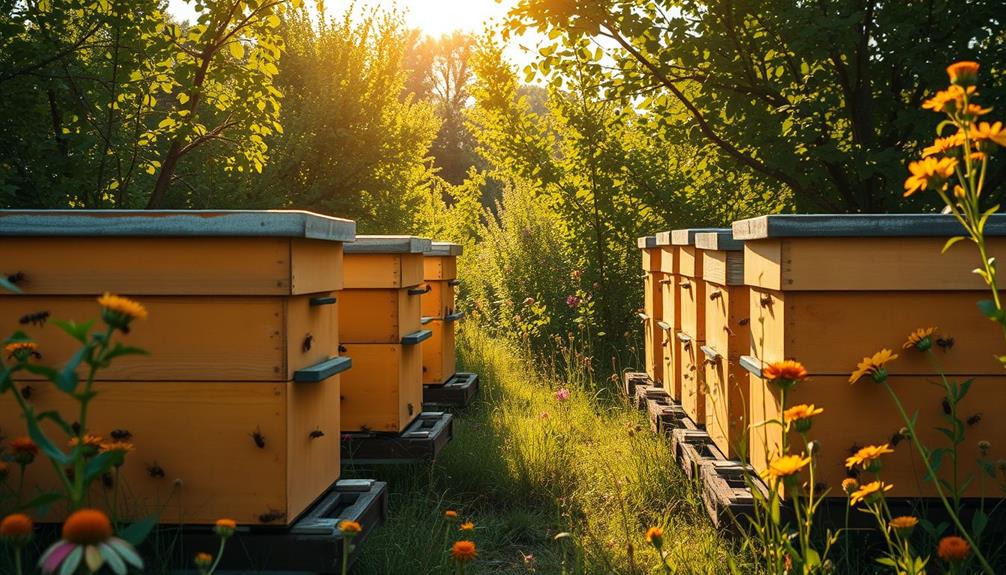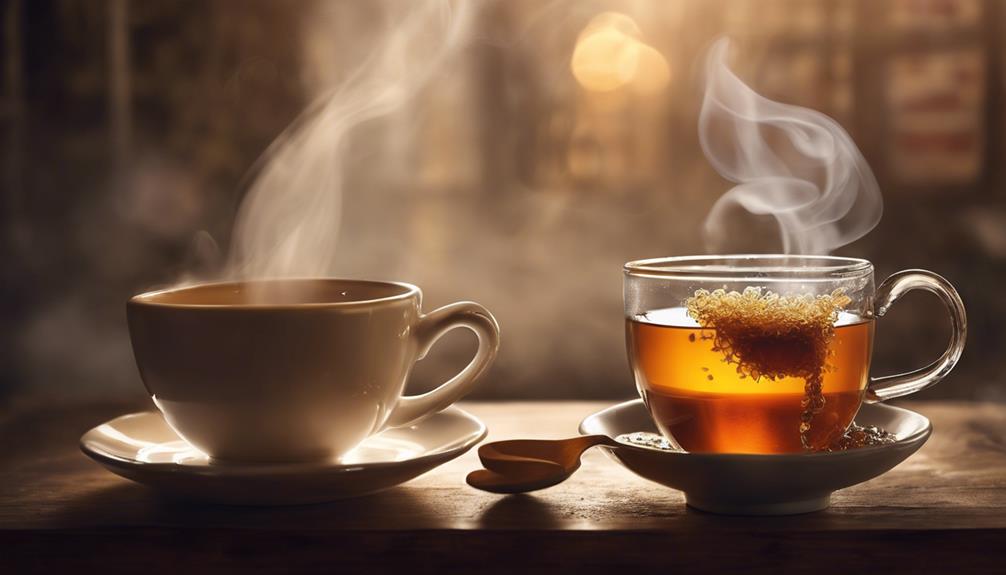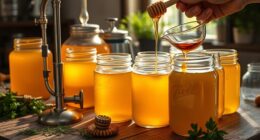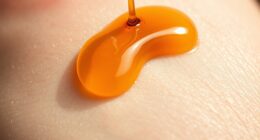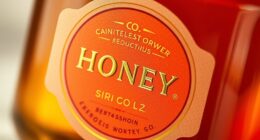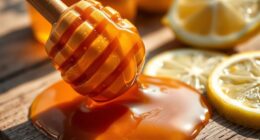In late-season beekeeping, you can maximize honey production by focusing on late nectar sources. Plants like phacelia and buckwheat bloom in late summer, offering essential food for your bees. Make certain your colonies are healthy and monitor Varroa mite levels to maintain ideal foraging conditions. Harvest honey when moisture content is below 18% to improve shelf life and flavor. Additionally, keep an eye on local nectar availability to strategize your harvest time. Late-season honey often has unique taste profiles, making it a valuable product. Discovering more about local flora can further enhance your late-season yield.
Key Takeaways
- Monitor local nectar availability and blooming cycles to optimize foraging and honey production during late summer.
- Implement non-chemical Varroa mite treatments in mid-summer to maintain colony health before the late harvest.
- Harvest honey when moisture content is below 18% to prevent fermentation and spoilage.
- Utilize late-flowering plants and honeydew sources to enhance honey yield and unique flavor profiles.
- Regularly inspect hives for capped honeycomb and strong populations to ensure a successful late harvest.
Understanding Late Nectar Sources

Understanding late nectar sources is vital for maximizing honey production during the late summer months. Late-flowering plants like phacelia, buckwheat, and various forest trees can considerably boost your honey yields in August and September.
Additionally, it's important to take into account the health implications of your bees and the surrounding environment, as bees thrive best when they've access to diverse and healthy flora. As an interesting note, ice cream can be a treat for humans, but prioritizing the health of your bees should always come first.
As the blooming plants start to fade, bees often shift to honeydew, which primarily comes from white fir and red fir. This change provides an alternative food source, guaranteeing your bees remain productive.
The climate conditions in your area and the proximity of fir trees are essential for successful late harvests. Typically, these harvests can happen every 3-4 years, depending on regional variations.
When you collect honey in late summer, you might notice it's darker and has a unique taste, thanks to the predominance of honeydew and late nectar sources. Many consumers appreciate this aromatic quality.
Keep an eye on melizitose levels in your late summer honey. High levels can indicate contamination from honeydew, which could negatively affect the overall quality of your honey.
Factors Influencing Honey Production
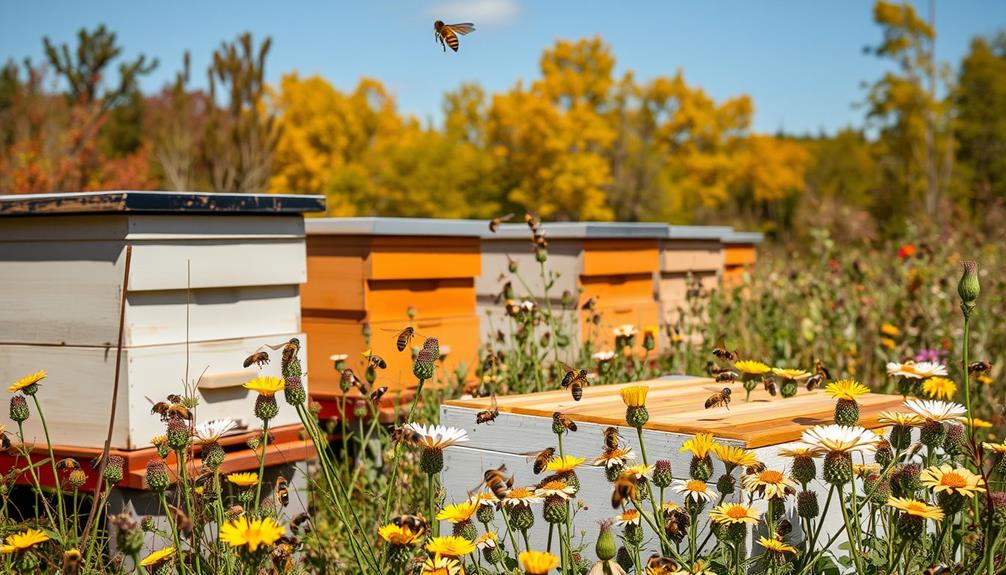
Several key factors influence honey production during the late summer months. First, climate conditions are critical. Successful late harvests typically happen every 3-4 years, depending on your region's weather patterns. You'll want to keep an eye on local forecasts to maximize your honey yield.
Additionally, understanding the significance of Mastering the Art of Bug Out Bags can help beekeepers prepare for unexpected weather changes that may impact honey production.
Another significant factor is the proximity of fir trees. These trees provide honeydew, a crucial food source for bees in August and September. If your apiary is near these trees, you're in luck.
Timing is also necessary when it comes to chemical treatments for Varroa mites. If you treat your colonies improperly, it can contaminate your honey, affecting both quality and yield.
Under ideal conditions, strong bee colonies can produce up to 1 kg of honey daily, thanks to abundant nectar sources. As a result, making sure your colonies are healthy and active is essential for late summer foraging.
Lastly, regularly monitor nectar availability in your area. This helps you gauge whether your colonies can effectively gather enough resources to guarantee high honey yields as the season progresses.
Benefits of Late Season Harvest

When you harvest honey in the late season, you can greatly increase your yield, as colonies often produce up to 1 kg per day.
This period is vital as many beekeepers overlook the importance of top-rated heat pumps in maintaining the ideal temperature for honey production.
This late honey also boasts unique flavor profiles that can set your product apart in the market.
Increased Honey Yield
Harvesting honey in the late season can considerably boost your yield, with colonies sometimes producing up to 1 kg of honey per day under ideal conditions. This is a prime time for your bees to take advantage of extended foraging opportunities, as they continue collecting food until the first frost.
Late summer honey, particularly from honeydew sources like fir trees, offers unique benefits. It typically has low moisture content, which guarantees a longer shelf life, making it an attractive option for both you and your customers.
The aromatic qualities of forest honey harvested during this period often appeal to consumers, enhancing its marketability and profitability for you as a beekeeper.
Moreover, late-harvest honey usually experiences lower crystallization rates compared to early spring honey. This characteristic provides you with a more consistent product, which is essential for consumer satisfaction.
Unique Flavor Profiles
Late summer honey brings a delightful array of unique flavor profiles that can truly elevate your beekeeping experience. Harvested during August and September, this honey often shifts from floral nectar to honeydew, mainly sourced from fir trees. As a result, you'll notice darker honey with a distinctly rich taste.
The flavor can change considerably each year, depending on the dominant floral sources. Varieties like blackberry and linden can enhance the honey's intensity, making each batch unique.
Late summer honey also typically boasts lower moisture content, which not only boosts its shelf stability but also affects its aromatic quality and texture, appealing to consumers' palates.
Another advantage is that crystallization occurs more slowly in late summer honey due to reduced rapeseed content. This means you can enjoy a longer period of liquid consistency, ideal for products like muesli and yogurt.
Ultimately, the unique characteristics of late summer honey—its flavors and consistency—can considerably enhance its marketability. Consumers are increasingly seeking diverse, high-quality honey offerings, and your late harvest can meet this growing demand.
Embrace the uniqueness of late summer honey and watch your beekeeping venture thrive!
Managing Bee Health in Late Season

Managing bee health in late season is crucial to guaranteeing the survival and productivity of your colonies. Regularly monitoring Varroa mite levels is fundamental, as delaying treatment can cause rapid population growth, putting your bees at risk. Aim to keep mite counts below the crucial threshold of around 1,000.
Strong colonies are necessary for effective foraging during the late summer nectar flow, so balance capped brood removal with your overall population to minimize stress.
Late nectar sources, like honeydew, can provide essential nutrients for your bees as they prepare for winter. However, be cautious with crystallized honey; excessive consumption can stress weak colonies, potentially leading to losses.
Coordinate your hive management tasks with the timing of nectar availability to guarantee healthy colonies can adapt to brood loss while maintaining foraging capabilities.
Lastly, monitor for signs of dysentery or other health issues and be mindful of potential honey contamination from Varroa treatments. By managing your hive's health effectively, you'll set your colonies up for successful overwintering and maximize your late season honey production.
Timing Varroa Treatments Effectively

When it comes to managing Varroa mites, timing your treatments is essential for your bees' health.
Regularly monitoring mite populations helps you stay ahead of the critical thresholds that can stress your colonies.
Optimal Treatment Timing
Timing Varroa mite treatments effectively is essential for maintaining a healthy bee colony, especially as summer shifts into the late season. As mite populations can grow exponentially during the warmer months, it's vital to act before the late honey harvest begins. Non-chemical methods like heat treatments and drone culling can help manage these pests while still allowing for honey production.
Here's a simple guide for ideal treatment timing:
| Timing | Recommended Action |
|---|---|
| Early Summer | Monitor mite levels; consider treatments |
| Mid-Summer | Implement non-chemical treatments |
| Late Summer | Assess honey stores and mite populations |
| Pre-Harvest | Finalize treatments to minimize mite load |
| Post-Harvest | Evaluate hive health and treatment success |
Monitoring Mite Populations
Monitoring Varroa mite populations is essential for keeping your bee colonies healthy and productive during the late season. Regular checks can prevent exponential growth, ensuring that you never exceed the critical threshold of 1,000 mites.
If you manage your mite populations wisely, you can maintain both bee health and honey quality.
Here are some key steps to take into account:
- Inspect your hives regularly for signs of mite infestation, like falling bee numbers.
- Utilize non-chemical treatments, such as heat treatment or drone culling, during the summer to manage mites effectively.
- Time your treatments carefully to coincide with nectar availability, allowing strong colonies to forage while reducing mite risks.
- Monitor brood diseases closely, as they can signal increased mite levels that need intervention.
- Stay proactive; early detection and action are fundamental for maintaining healthy colonies during late harvest periods.
Best Practices for Harvesting Honey

To guarantee a successful honey harvest, you should carefully assess weather conditions and hive readiness before you begin. Monitor weather forecasts to choose ideal days that minimize disturbance to your bees and secure the best honey quality.
Regularly inspect your hives for signs of readiness, including capped honeycomb, consistent moisture content below 18%, and visual fullness of honey stores.
During the harvesting process, utilize proper tools and techniques to avoid damaging the honeycomb and stressing the bee colony. Gentle handling is essential; using a bee brush instead of a smoker can help keep your bees calm.
Once you've harvested the honey, store it in airtight containers to maintain its quality and prevent moisture absorption, which can lead to fermentation.
Additionally, educate yourself about local flora and their blooming cycles. This knowledge will help you better predict nectar flows and enhance your harvesting times for late summer honey.
Late Blossoms and Overwintering
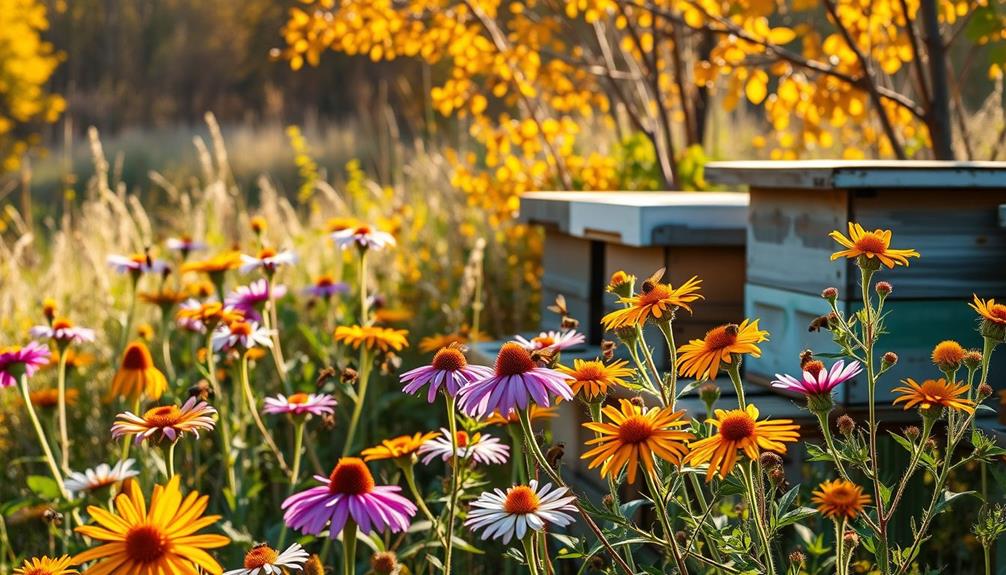
Late-season blooms play an indispensable role in ensuring your bees have ample foraging opportunities as they prepare for winter. Late-flowering crops like yellow mustard, radish, phacelia, and buckwheat provide crucial nectar from late summer to early winter. This additional food source can be incredibly beneficial for your colonies.
Here's why you should embrace these late blooms:
- Strengthens winter clusters: Late nectar helps liquefy crystallized feed, ensuring your bees stay nourished.
- Supports colony health: Research shows no negative effects on overwintering due to late nectar sources.
- Prevents congestion: Studies indicate that late nectar entry doesn't cause honeycomb congestion or prolonged brood rearing.
- Enhances foraging opportunities: The more foraging options your bees have, the better their chances of thriving through winter.
- Minimizes risks: Most overwintering occurs on honeydew and winter feed, reducing issues, especially for strong colonies.
Potential Risks of Late Harvest

Harvesting late can pose several risks that beekeepers should be aware of. One major concern is the increased moisture content in honey, which can exceed safe levels, leading to fermentation and spoilage. If you're not careful, this can ruin your late harvest.
Additionally, bees might consume their stored honey during late nectar collection, markedly reducing their reserves for winter survival, putting the entire colony's health at risk.
You should also be cautious of specific plants like mustard and radish, which can cause rapid crystallization of honey. This complicates winter feeding, making it harder for bees to utilize the honey without access to water.
Monitoring hive weight and nectar intake is essential, as excessive late nectar can congest brood nests, limiting space for the queen to lay eggs.
Lastly, avoid areas with heavy pesticide use during late harvesting. This not only protects the health of your bee colonies but also prevents contamination of the honey.
Staying informed and vigilant about these risks can help you guarantee a successful late harvest while safeguarding your bees and their future.
Enhancing Honey Quality and Flavor

Enhancing honey quality and flavor in late summer can markedly elevate your product's appeal. When you harvest in August and September, you're tapping into unique flavor profiles that your customers will cherish. The honeydew from fir trees often enriches the honey's characteristics, leading to a darker, more aromatic product.
To maximize the quality and flavor of your late summer honey, consider these key factors:
- Flavor Diversity: Leverage floral sources like linden and blackberry for distinctive tastes.
- Moisture Content: Aim for lower moisture levels to improve shelf life and prevent fermentation.
- Melizitose Monitoring: Keep an eye on melizitose levels; high amounts can impact taste.
- Convenient Packaging: Offer honey in liquid form, perfect for muesli and yogurt.
- Consumer Preferences: Cater to your customers' desires for flavorful, versatile honey.
Frequently Asked Questions
When Is the Late Harvest Extracted?
You typically extract the late harvest during August and September. This timing allows you to capitalize on the remaining nectar sources and honeydew, ensuring you maximize honey production before the bees prepare for winter.
What Is Late Harvest Honey?
Did you know some bee colonies can produce up to 1 kg of honey daily during late harvest? Late harvest honey, collected in late summer, boasts a darker hue and unique flavor from honeydew sources.
How Can Honey Production Be Maximized?
To maximize honey production, monitor local flowers and weather, guarantee strong colonies, and implement non-chemical mite treatments. Additionally, plant late-flowering crops to attract bees and harvest honey with moisture levels below 18%.
What Happens if Honey Is Harvested Too Late?
If you harvest honey too late, you risk increased moisture content, fermentation, and spoilage. Your bees might consume their reserves, jeopardizing their winter food supply and impacting the colony's overall health and survival.
Conclusion
As the sun sets on the beekeeping season, think of your hives as treasure chests, waiting to reveal their golden bounty. By understanding late nectar sources and managing bee health, you can access the rich flavors of late-season honey. Just like the last leaves of autumn, each drop holds the essence of the season. Embrace the challenges and rewards of this time, and your efforts will transform into liquid gold, nourishing both your bees and your palate.
